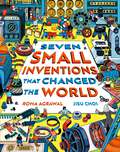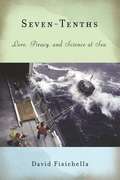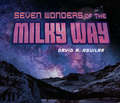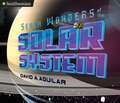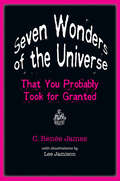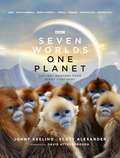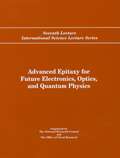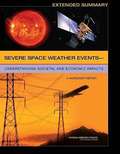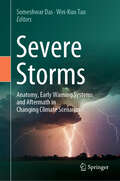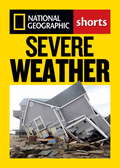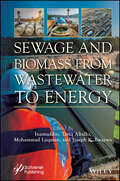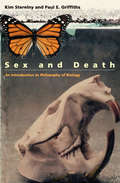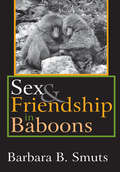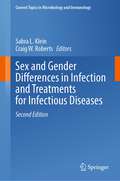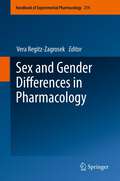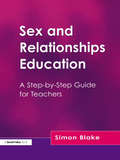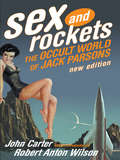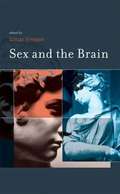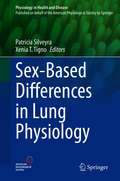- Table View
- List View
Seven Small Inventions that Changed the World
by Roma AgrawalTechnology and engineering surround us. From HUGE things, like spaceships and skyscrapers, to much smaller things like the toaster in our kitchen and the shoes on our feet. But all of these things only exist because of seven small inventions: the nail, the wheel, the spring, the magnet, the lens, the pump and ... string. And each of these inventions has a fascinating story to tell.Travel through centuries of history, through ancient Egypt, along the Silk Road, across the high seas and even into space, and discover how each of these seven small inventions came to be, how they work and how they changed the world forever. Find out how it's thanks to the potter's wheel that the International Space Station exists, and how the same nails that built pirate ships hold together the tallest buildings in the world. In this children's illustrated adaptation of her adult book, Nuts and Bolts, award-winning engineer turned bestselling author Roma Agrawal makes STEM accessible, intriguing and aspirational, and encourages children to be endlessly curious about the 'things' that make up our world.
Seven-tenths: Love, Piracy, and Science at Sea
by David FisichellaA disillusioned man and a blind oceanographer find love and adventure while studying the world's oceans.
Seven-Tenths
by David FisichellaAn engineer whose life is in shambles meets a blind oceanographer who spends her life at sea. In this memoir of their courtship, David Fisichella writes of science, love, adventure, and danger on the ocean. He survives heavy weather, an equator crossing, and a pirate attack off the coast of Somalia. He learns how scientists study ocean physics and why their research is so important, how people live for months on a crowded boat, and what it means to be working for, and dating, the chief scientist. Told with humor, gritty details, and a refreshing sense of wonder about our oceans.
Seven Wonders of the Milky Way
by David A. AguilarWitness the wonders of the Milky Way in this stunningly illustrated book that will make you feel like an astronaut!Blast off to the oldest star in our galaxy, zoom around planetary nebulae dubbed "the butterflies of space," circle past humongous, ringed exoplanets, and close in on newly discovered orbs that just might support alien life. David Aguilar, former Director of Science Information at the Harvard Smithsonian Center for Astrophysics, and creator of Cosmic Catastrophes and Seven Wonders of the Solar System, takes us on a unique space journey through the Milky Way. His beautifully rendered, painterly images are based on the latest scientific findings about our galaxy and are supported by lively, factual text about celestial wonders such as Omega Centauri, the Great Nebula in Orion, UY Scuti, the Hourglass Nebula, and headlining-making discoveries about planet J1407b, Tabby's Star, and the TRAPPIST-1 planetary system.
Seven Wonders of the Solar System (Smithsonian)
by David A. AguilarReady for a wondrous celestial journey? This extraordinary book puts you right there in the middle of our solar system: breaking through colorful gaseous hazes; exploring the surface of red-hot or ice-cold planets; hurtling through rings of flying, frozen ice chunks; and rocketing on out to deep space. Astronomer David Aguilar is our navigator on these seven wonderful trips through space—journeys that someday may actually happen!
Seven Wonders of the Universe That You Probably Took for Granted
by C. Rene JamesA fascinating look at the scientific mysteries behind our everyday world—from night, light and gravity to our cosmic home and wonder itself.So much of what surrounds us feels familiar and mundane—until we look closer. C. Renée James opens the Universe to fantastical contemplation in this whimsical tour of seven everyday experiences: night, light, stuff, gravity, time, home, and wonder. James introduces each of these seven wonders with a simple question that appears to be easily answered. The questions are deceptive, though. Although we need light to see, there’s much more to it than meets the eye. When you get down to the atomic level, physical things are made of almost entirely empty space—99.9% nothing. And James’s contemplation of our place in the Universe shows that it’s not just a place to hang your hat—and that there’s really nothing else like it.James’s accessible discussion uses common analogies and entertaining illustrations to explain historical discoveries and concepts such as relativity, antimatter, and the electromagnetic spectrum. Fun and edifying, Seven Wonders of the Universe That You Probably Took for Granted is an inviting introduction to secret knowledge of our everyday world.
Seven Wonders of the Universe That You Probably Took for Granted
by C. Renée JamesTime. Gravity. Night. So much of what surrounds us feels familiar and mundane. But each is a wonder that reveals profound insights into the world around us.C. Renée James's whimsical tour of seven everyday experiences—night, light, stuff, gravity, time, home, and wonder—opens the Universe to fantastical contemplation. Light? Although we need it to see, there's much more to it than meets the eye. Stuff? When it comes down to it, things are almost entirely empty space—99.9% nothing—especially when you get to the atomic level. Home? James's contemplation of our place in the Universe shows that it's not just a place to hang your hat—and that there’s really nothing else like it. James introduces each of these seven wonders with a simple question that appears to be easily answered. The questions are deceptive, though—as is James's casual, light-hearted style. Underneath lie such concepts as relativity, matter and antimatter, and the electromagnetic spectrum. Her accessible discussion uses common analogies and entertaining illustrations to provide a bundle of detail on historical discoveries and to provoke serious pondering. Fun and edifying, Seven Wonders of the Universe That You Probably Took for Granted is an inviting introduction to secret knowledge of our everyday world. This book may be 99.9% nothing, but the thoughts it will inspire are massive.
Seven Worlds One Planet
by Jonny Keeling Scott AlexanderWelcome home. A place 200 million years in the making.Long ago, our planet had only one gigantic land mass. Then something monumental happened. That supercontinent ruptured and seven different worlds were born. Each of those worlds - or continents - evolved, and continues to evolve, its own way of life. From the jungle of the Congo or the majestic Himalayas to the densely populated wilds of Europe or the comparatively isolated Australasia, Seven Worlds, One Planet explores the natural wonders that give each of our continents its distinct character. Following the animals that have made these iconic environments their home, it discovers spectacular wildlife stories that reveal what makes each of these seven worlds unique. With a foreword by Sir David Attenborough and over 250 breathtaking images, including stills from the BBC Natural History Unit’s spectacular footage, Seven Worlds, One Planet is a stunning exploration of the planet, and the worlds within it, that we call home.
Seventeenth Interim Report of the Committee on Acute Exposure Guideline Levels
by National Research Council of the National AcademiesExtremely hazardous substances (EHSs) can be released accidentally as a result of chemical spills, industrial explosions, and other accidents, or intentionally through terrorist activities. Workers and residents in communities surrounding industrial facilities where EHSs are manufactured, used, or stored and in communities along the nation's railways and highways are potentially at risk of being exposed to airborne EHSs during accidental or intentional releases. To help understand the risk involved with EHSs, the National Advisory Committee (NAC) on Acute Exposure Guideline Levels for Hazardous Substances developed Acute Exposure Guideline Levels (AEGLs) for approximately 200 EHSs. The present volume is the seventeenth interim report evaluating the AEGLs.
Seventh Lecture International Science Lecture Series: Advanced Epitaxy For Future Electronics, Optics, And Quantum Physics
by Arthur C. GossardThe National Academies Press (NAP)--publisher for the National Academies--publishes more than 200 books a year offering the most authoritative views, definitive information, and groundbreaking recommendations on a wide range of topics in science, engineering, and health. Our books are unique in that they are authored by the nation's leading experts in every scientific field.
Severe Space Weather Events-- Understanding Societal And Economic Impacts: A Workshop Report
by National Research Council of the National AcademiesThe adverse effects of extreme space weather on modern technology--power grid outages, high-frequency communication blackouts, spacecraft anomalies--are well known and well documented, and the physical processes underlying space weather are also generally well understood. Less well documented and understood, however, are the potential economic and societal impacts of the disruption of critical technological systems by severe space weather. This volume, an extended four-color summary of the book, http://www.nap.edu/catalog.php?record_id=12507Severe Space Weather Events--Understanding Societal and Economic Impacts, addresses the questions of space weather risk assessment and management. The workshop on which the books are based brought together representatives of industry, the government, and academia to consider both direct and collateral effects of severe space weather events, the current state of the space weather services infrastructure in the United States, the needs of users of space weather data and services, and the ramifications of future technological developments for contemporary society's vulnerability to space weather. The workshop concluded with a discussion of un- or underexplored topics that would yield the greatest benefits in space weather risk management.
Severe Storms: Anatomy, Early Warning Systems and Aftermath in Changing Climate Scenarios
by Someshwar Das Wei-Kuo TaoThe book provides information on the observational aspects of the severe storms through satellite, radar, aircraft, and ground based network of stations and these issues are discussed in the first part of the book consisting of 8 chapters. The numerical modelling and data assimilation techniques are discussed in the second part of the book aimed at development of Early Warning Systems (12 chapters) and finally the outlook of the severe storms in a changing climate scenario, their socio-economic impacts and policies for disaster mitigation are discussed in the third part of the book consisting of 6 chapters. This book is of great interest to atmospheric scientists and other researchers, practitioners, policy and decision makers, international institutions, governmental and non-governmental organizations, educators, as well as students.
Severe Weather
by Kathy Furgang Brett KellyWhat causes major storms and how can you stay safe when one blows in? Why is it important to have an emergency plan? Read this book to find out how you can predict severe weather conditions and protect yourself against them. (Set of 10)
Severe Weather
by National GeographicWeather-related tragedies have fascinated humans throughout time. For those who loved The Perfect Storm andKrakatoa, the millions who log onto daily weather forecasting sites and check weather apps, and people who can't get enough front-page headlines of global natural disasters. Earthquakes, hurricanes, tornados, floods, forest fires, blizzards, and thunderstorms: National Geographic explores the deadliest of these disasters throughout history and arms you with ways to protect yourself from chaos and destruction. From the 1906 earthquake that flattened San Francisco and the morbid 1889 flash flood that wiped out the entire town of Johnstown, Pennsylvania, to the Superstorm of 1993 that blanketed Florida in snow and the more recent East Coast and Gulf Coast ravages of hurricanes Katrina and Sandy, the destructive force and human tragedy both fascinates and horrifies. In addition to these gripping stories, NGS provides practical tips for surviving at home and weathering the lethal strength of these events if caught outside.
Sewage and Biomass from Wastewater to Energy: Possibilities and Technology
by Inamuddin Mohammad Luqman Tariq Altalhi Joseph KapukuWritten and edited by a team of industry experts, this exciting new volume covers clean energy production from sewage and biomass while achieving a zero-waste strategy. Wastewater treatment plants are critical in protecting both the environment’s resources and human health. A wastewater treatment plant’s technological system focuses not only on the effectiveness of the treatment but on the costs and energy consumption of the entire system. Municipal wastewater treatment produces a significant amount of sewage sludge all over the world. The majority of this sludge’s dry matter content is made up of organic compounds which are not toxic, and they consist of both primary and secondary (microbiological) sludge. There is also a substantial quantity of inorganic substances in the sludge, along with a small quantity of toxic matter. Also, various raw sewage treatment options can include energy production (heat, electricity, or biofuel) to reduce dependence on external energy supply during treatment. The most important options used for energy production from sewage and biomass can use the following approaches: anaerobic digestion, co-digestion, incineration with energy recovery, co-incineration, pyrolysis, gasification, supercritical (wet) oxidation, and hydrolysis. Generally, these processes or methods are cost-effective, but they can still have some setbacks related to the nature of the methods or the raw material used for conversion. There are also operating conditions to comply with to get a successful outcome. This book combines information from many disciplines related to wastewater treatment technologies to show how the circular economy approach can be used to achieve zero waste and produce energy that can be useful for plants and communities. This approach focuses on clean technologies for green energy resources such as biohydrogen, biofuels, and biogas from biomass and sewage sludge for zero waste production. This is aimed to also integrate the issue of energy demand and the one of energy production.
Sex Addiction as Affect Dysregulation: A Neurobiologically Informed Holistic Treatment (Norton Series On Interpersonal Neurobiology Ser. #0)
by Alexandra KatehakisExamining the neurobiological underpinnings of sex addiction. Neuroaffective science—studying the integrated development of the body, brain, and mind—has revealed mechanisms linking psychological and biological factors of mental disorders, including addiction. Indeed, its paradigm-shifting theoretical umbrella demonstrated that substance and behavioral dependencies share identical neurobiological workings, and thus that problematic repetitive behaviors are genuine addictions—a state increasingly understood as a chronic brain disorder. Clinical experience strongly suggests that sex addiction (SA) treatment informed by affective neuroscience—the specialty of Alexandra Katehakis—proves profoundly transformative. Katehakis's relational protocol, presented here, blends neurobiology with psychology to accomplish full recovery. Her Psychobiological Approach to Sex Addiction Treatment (PASAT) joins therapist and patient through a relationally-based psychotherapy—a holistic, dyadic dance that calls on the body, brain, and mind of both. Written with clarity and compassion, this book integrates cutting-edge research, case studies, verbatim session records, and patient writings and art. Katehakis explicates neurophysiological, psychological, and cultural forces priming and maintaining SA, then details how her innovative treatment restores patients' interpersonal, sexual, and spiritual relationality.
Sex and Death: An Introduction to Philosophy of Biology
by Kim Sterelny Paul E. GriffithsIs the history of life a series of accidents or a drama scripted by selfish genes? Is there an "essential" human nature, determined at birth or in a distant evolutionary past? What should we conserve—species, ecosystems, or something else? Informed answers to questions like these, critical to our understanding of ourselves and the world around us, require both a knowledge of biology and a philosophical framework within which to make sense of its findings. In this accessible introduction to philosophy of biology, Kim Sterelny and Paul E. Griffiths present both the science and the philosophical context necessary for a critical understanding of the most exciting debates shaping biology today. The authors, both of whom have published extensively in this field, describe the range of competing views—including their own—on these fascinating topics. With its clear explanations of both biological and philosophical concepts, Sex and Death will appeal not only to undergraduates, but also to the many general readers eager to think critically about the science of life.
Sex and Death: An Introduction to Philosophy of Biology (Science And Its Conceptual Foundations S Ser.)
by Kim Sterelny Paul E. GriffithsIs the history of life a series of accidents or a drama scripted by selfish genes? Is there an "essential" human nature, determined at birth or in a distant evolutionary past? What should we conserve—species, ecosystems, or something else? Informed answers to questions like these, critical to our understanding of ourselves and the world around us, require both a knowledge of biology and a philosophical framework within which to make sense of its findings. In this accessible introduction to philosophy of biology, Kim Sterelny and Paul E. Griffiths present both the science and the philosophical context necessary for a critical understanding of the most exciting debates shaping biology today. The authors, both of whom have published extensively in this field, describe the range of competing views—including their own—on these fascinating topics. With its clear explanations of both biological and philosophical concepts, Sex and Death will appeal not only to undergraduates, but also to the many general readers eager to think critically about the science of life.
Sex and Friendship in Baboons (Evolutionary Foundations Of Human Behavior Ser.)
by Barbara B. SmutsThose who have been privileged to watch baboons long enough to know them as individuals and who have learned to interpret some of their more subtle interactions will attest that the rapid flow of baboon behavior can at times be overwhelming. In fact, some of the most sophisticated and influential observation methods for sampling vertebrate social behavior grew out of baboon studies, invented by scientists who were trying to cope with the intricacies of baboon behavior. Barbara Smuts' eloquent study of baboons reveals a new depth to their behavior and extends the theories needed to account for it.While adhering to the most scrupulous methodological strictures, the author maintains an open research strategy--respecting her subjects by approaching them with the open mind of an ethnographer and immersing herself in the complexities of baboon social life before formulating her research design, allowing her to detect and document a new level of subtlety in their behavior. At the Gilgil site, described in this book, she could stroll and sit within a few feet of her subjects. By maintaining such proximity she was able to watch and listen to intimate exchanges within the troop; she was able, in other words, to shift the baboons well along the continuum from ""subject"" to ""informant."" By doing so she has illuminated new networks of special relationships in baboons. This empirical contribution accompanies theoretical insights that not only help to explain many of the inconsistencies of previous studies but also provide the foundation for a whole new dimension in the study of primate behavior: analysis oft he dynamics of long-term, intimate relationships and their evolutionary significance.At every stage of research human observers have underestimated the baboon. These intelligent, curious, emotional, and long-lived creatures are capable of employing stratagems and forming relationships that are not easily detected by traditional research methods. In the process
Sex and Gender Differences in Infection and Treatments for Infectious Diseases (Current Topics in Microbiology and Immunology #441)
by Sabra L. Klein Craig W. RobertsThis fully revised and significantly expanded second edition examines sex and gender differences in the immune system's response to bacterial, viral, and parasitic infections. The volume discusses both common and distinct molecular mechanisms that mediate these differences and illustrates how responses to vaccines may differ between the sexes and in pregnant individuals. Special emphasis is placed on the interplay between hormones and the immune system in the pathogenesis of HIV, SARS-CoV-2, influenza, malaria, tuberculosis, and amebiasis. This second edition includes completely rewritten chapters as well as all new contents.This book is intended for researchers in academia and industry as well as clinicians in the fields of microbiology, immunology, and pharmacology. By expanding knowledge in sex and gender medicine as a basis for developing personalized treatment strategies, the book contributes to UN Sustainable Development Goals 3 (health and well-being) and 5 (gender equality).
Sex and Gender Differences in Pharmacology
by Vera Regitz-ZagrosekThis is the very first book to deal with sex and gender differences in drug therapy - an increasingly recognized medical need. It starts with an overview on S/G in clinical syndromes and a documentation of the medical and socioeconomic damage caused by gender specific adverse drug effects. Part I covers S/G differences in pharmacokinetics. Researchers will be satisfied by the detailed discussion of the mechanisms of S/G differences in drug effects that represents cutting edge science and includes interaction of drugs with sex hormones, genomic and epigenetic mechanisms. It also covers S/G in drug development, in animal models and clinical development and S/G in drug prescriptions. Part II targets S/G differences in drug effects in cardiovascular, pulmonary, CNS, neuromuscular, neuropsychiatric and metabolic diseases, in cancer, inflammation, and rheumatic diseases, in bacterial and retroviral infections, thrombosis, embolism. New drugs will be discussed.
Sex and Relationships Education: A Step-by-Step Guide for Teachers (Spotlight Ser.)
by Simon BlakeThis book will enable and assist teachers responsible for organizing and delivering Sex and Relationships Education. It draws together the best available practice to support teachers in developing policy and classroom practice. It begins by looking at general principles and then focuses on primary, secondary and special schools as well as pupil referral units. These chapters will provide a toolkit of ideas and approaches that teachers can use in the classroom. Included are practical exercises that can be done alone or in staff meetings to prepare yourself or a colleague to deliver SRE, a glossary of terms that will support you in answering children's and young people's questions, advice on choosing, developing and using resources, and a list of useful organizations and websites. The book will be particularly helpful to PSHE coordinators, Health Promotion Units, National Healthy School Standard coordinators and SRE teachers in schools. LEA Advisors and Inspectors, and anyone involved in training and supporting teachers, will also find this a useful guide.
Sex and Rockets
by John Carter Robert Anton WilsonThis remarkable true story about the co-founder of Jet Propulsion Laboratory. By day, Parsons' unorthodox genius created a solid rocket fuel that helped the Allies win World War II. By night, Parsons called himself The Antichrist. "One of the best books of the year."--The Anomalist
Sex and the Brain
by Gillian EinsteinThis collection of foundational papers on sex differences in the brain traces the development of a much-invoked, fast-growing young field at the intersection of brain and behavior. The reader is introduced to the meaning and nature of sexual dimorphisms, the mechanisms and consequences of steroid hormone action, and the impact of the field on interpretations of sexuality and gender. Building on each other in point-counterpoint fashion, the papers tell a fascinating story of an emerging science working out its core assumptions. Experimental and theoretical papers, woven together by editor's introductions, open a window onto knowledge in the making and a vigorous debate between reductionist and pluralist interpreters. Five major sections include papers on conceptual and methodological background, central nervous system dimorphisms, mechanisms for creating dimorphisms, dimorphisms and cognition, and dimorphisms and identity. Each section builds from basic concepts to early experiments, from experimental models to humans, and from molecules to mind. Papers by such leading scholars as Arthur Arnold, Frank Beach, Anne Fausto-Sterling, Patricia Goldman-Rakic, Doreen Kimura, Simon LeVay, Bruce McEwen, Michael Merzenich, Bertram O'Malley, Geoffrey Raisman, and Dick Swaab, illustrate a rich blend of perspectives, approaches, methods, and findings. Sex and the Brainwill show students how a scientific paper can be analyzed from many perspectives, and supply them with critical tools for judging a rapidly emerging science in a contentious area.
Sex-Based Differences in Lung Physiology (Physiology in Health and Disease)
by Patricia Silveyra Xenia T. TignoThis book provides an overview of the latest experimental work on sex-based differences in lung function and inflammation. Readers will learn how these differences relate to individual predispositions for the development of lung disease in men and women, and in different stages of their reproductive lives. Further, the book focuses on diseases that predominantly affect women or men, with an emphasis on the physiological mechanisms underlying their pathobiology. In turn, these findings are complemented by chapters on recent studies, which investigate how circulating sex hormone levels impact the lung’s innate immune response to environmental agents and air pollution. The pathogeneses of asthma and viral respiratory infection are also major focus areas. As an outlook, the book also discusses current and future research directions aimed at developing sex-specific therapies for lung disease. To examine these anatomical and physiological differences in the male and female respiratory systems, the authors employ a broad range of methods from molecular and clinical biology. Accordingly, the book will be a fascinating read for physiologists and clinicians alike.
